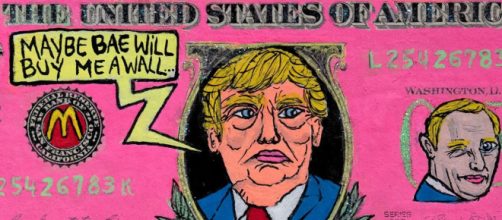Not every story about art and money is as senseless as Warhol’s rendering of 200 dollar bills that sold at Sotheby’s for $43.8 million in 2009. Consider this latest news: The Fitzwilliam Museum exhibit of money defaced in protest.
The exhibit, titled “Defaced!” is a 250-year survey of currency sullied in rebellion, such as the struggles of the suffragettes, the Jews in Nazi concentration camps, and Black Lives Matter.
Exhibit literature quotes the artist Mark Wagner, known for reconfiguring dollar bills in dissent, saying: "If you're fed up and throwing rocks isn't your thing, take it out on money."
Paying the price
Taking it out on money takes the form of over-printing or digitally manipulating imagery.
And such protests are guaranteed a wide audience since money constantly changes hands.
The eye-catcher in this history of protesting by defacing currency is Sean Kushner's dollar bill bearing the face of Donald Trump and Vladimir Putin to get his U.S./Mexico border wall built.
While using currency to push a complaint has served many causes, it seemed especially fitting in Kushner’s gripe against Trump owing to the ex-president’s love of money. According to his former lawyer, Michael Cohen, the almighty dollar drives his every decision.
In remarks in an interview on MSNBC to promote his memoir “Revenge” last week, Cohen predicted that Trump won’t run for office in 2024. “He’s making too much money by not running.”
As Cohen explained, a stipulation in the super PAC that Trump uses to raise money for republican candidates allows him to use 90 percent of every dollar any way he wants.
All donations, then, are a “slush fund” for him, Cohen said. If he runs, all the money would go to his campaign. End of money train for him.
Cohen said that Trump took in $100 million this year and didn’t spend much on the candidates he endorsed. “The funds went to pay for his lifestyle.”
Trump’s $10 million 'Renoir'
You may think his lifestyle includes collecting art in view of his bombast about his “Renoir.” But the bragging right is not the art.
It’s the cost, not the art.
In 2015, Vanity Fair reporter Mark Bowden told of his experience aboard Trump's Boeing 727 when he was shown Renoir’s “La Loge” on the cabin wall and was told the painting cost $10 million.
Trump's “Renoir” is a reproduction. The original hangs in the Courtauld Institute of Art in London. He dismissed that fact along with the bogus amount he paid for it.
Trump’s love of money raised its greedy head early on. In 1979 he bought a century-old Manhattan landmark – the upscale Fifth Avenue department store called Bonwit Teller – and demolished it to build his Trump Tower.
Preservationists implored him to avoid destroying a pair of 15-foot Art Deco sculptures of female dancers attached to the main entrance along with decorative grillwork. Trump agreed to save the art and to donate it to the Metropolitan Museum of Art.
But his demolition crew jackhammered the sculptures to pieces. Then, using a fake name of John Baron to represent his company, Trump said in a statement to the Daily News, “The merit of the stones was not great enough to justify the effort to save them.”
The real reason for the demolition was revealed when Baron (a.k.a.
Trump) said the removal process could have set back Trump Tower’s construction timeline by two weeks. Art may be forever [Ars longa, vita brevis], as the ancient Greeks used to say, but to Trump, time is money.
Kushner's dollar bill bearing the face of Donald Trump is a great protest covering a multitude of his sins.


